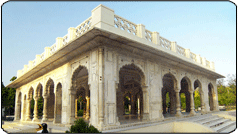Baradari at Banarsi Bagh
On a holiday, the Zoological gardens situated at Banarsi Bagh appear to be the most favourite spot for picnickers, specially families with children, on an outing. The lawns of the Baradari in the compound overflow with visitors but there are few amongst them who are aware of the historical importance of the place.
Baradari is a term normally used for a covered pavilion, devoid of walls, windows and doors allowing unhindered flow of air (but there are also enclosed Baradaries provided with doors and windows). Dar means archway or doorway and bara is twelve, therefore Baradari would mean a hall or pavilion with twelve arches or doorways [having three openings on each of the four sides].
However, this arrangement is not sirsctiy followed and the number of openings in the form of arches and doorways can also be more. Twelve was perhaps chosen as a number because it is astrologically significant for the Nawabs of Awadh, who were Asna-e-Ashri Shia Muslims and twelve was significant for the number of their Imams. But five was equally important for Panjatan - the Holy five of the Prophet's family. Interestingly therefore, one will find in the buildings of the Nawabs, a unique arrangement that combines the presence of both these numbers. The facade and outer sides of the building have five archways or doorways and three of them are incorporated with the main hall leaving the ones on the sides for entry to the galleries around the hall. Thus the main hall has three arches on four sides making a total of twelve. Such an arrangement is however, restricted for use only with square shaped building plans. The Safed Baradari in Qaiser Bagh, which was originally an Imambara named Qasr-ul-Buka [Qasr-ul-Aza] is an example of this type of twelve and five combination.The Nageene wali Baradari in the Banarsi Bagh (Zoo) is another example.
The name Banarsi Bagh for the gardens, according to Sidney Hay in Historic Lucknow was because of certain plants specially brought from Banaras (Varanasi) that were planted in the garden. Hay also mentions that there was a double storeyed summer house where now stands the Baradari.
Maulana Agha Mehdi in Taareekh-e-Lucknow says that Nageene wali Baradari in white marble was built in 1229 Hijri (1814). [This was the reign of Nawab Saadat Ali Khan and hence he appears to be the builder of Nageene wali Baradari]. Agha Mehdi has produced a four line chronogram in Persian to support this fact. He illustrates the clever device of the poet manifested in the composition's last line being remarkable where he uses the word nageen (jewel) at two places, once where it is used in the name of the structure itself and once for the adulation of the builder presenting him as Nageen-e-Hind, the Jewel of India.
Agha Mehdi also suggests that the Baradari was ornamented with inlay of jewels (nageene) which were looted during the conflict of 1857 and left pock marks on the structure's surface [which he adds 'appeared like the face of a person afflicted with small pox'].
Agha Mehdi also informs that Ghulam Raza Khan titled" Sharaf-ud-Daulah was given the charge of provisions and supplies for the forces of the freedom fighters (under Prince Birjis Qadr's brief reign with Rajmata Begum Hazrat Mahal as his regent). He stored grains worth ten thousand rupees behind the Nageene wali Baradari, but this stock only proved beneficial to the Company for feeding their soldiers after the victory.
Maulana Agha Mehdi refutes Najmul Ghani's description [in Taareekh-e-Awadh] of Qaiser Bagh having the Nageene wali Baradari. We find many other writers stating that the Baradari was in Qaiser Bagh. Surendra Mohan gives the same location and says that it was built by Naseer-ud-Din Haider (1827-1837) the second King of Awadh.
The attractive Nageene wali Baradari at Banarsi Bagh (or Hazrat Bagh as named by Agha Mehdi) is under the control of the Forest department of the State government and it was skilfully repaired and restored again some years back under the supervision of the State Archaeology Directorate. The 24 pillared, white marble structure is a good example of craftsmanship in stone, which was rarely used by the Nawabs [and Kings] of Awadh in their buildings.
Source:
Hindustan Times, City Scan, A Time in History
Wednesday 6.1.1999 — Nageene wali Baradari

